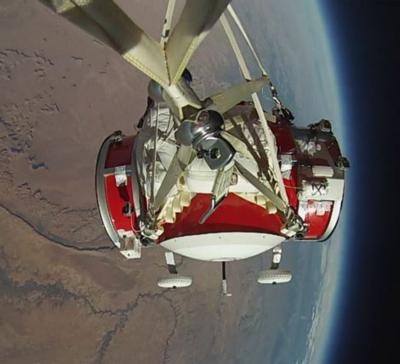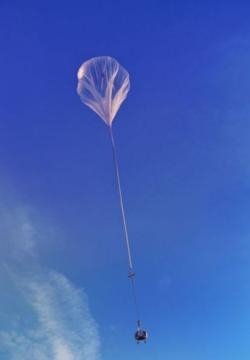Readies The Company To Begin Full Scale Flight Testing For Human Private Spaceflights
A commercial spaceflight company that will use a balloon rather than a rocket to take tourists to the edge of space has successfully completed a major milestone test flight this past weekend, keeping the company on track to meet its 2017 goal for private flights with passengers to the edge of space.

This test flight carried a scaled down, replica World View spacecraft to a final altitude of 100,475 feet, successfully marking the transition from sub-scale testing to a historical next stage of development – full scale testing.
This sub-scale test flight demonstrated foundational technologies necessary for regular, operational flight, and proves that commercial flight to the edge of space via high-altitude balloon will serve as a viable and major form of transport in the emerging private space travel industry. The flight launched from Page, Arizona, one of the locations from where World View plans to fly Voyagers to the edge of space.
World View’s Chief Executive Officer and Co-Founder Jane Poynter attributes the success to the incredible team of engineers at World View, many of whom were part of the StratEx Space Dive program that carried former Google Executive Alan Eustace to 136,000 feet beneath a high-altitude balloon in October 2014. “Our team is comprised of some of the best aerospace engineers in the world and they’ve achieved some major technological advancements in the last few months. Those efforts have resulted in new and innovative technologies that will, without a doubt, make private travel to the edge of space routine in the years to come. This test flight is symbolic of a major step towards a new era of accessible space travel for us all.”
Before advancing to full-scale system testing, World View needed to combine two critical achievements from past milestone flights; high-altitude parafoil flight and full flight operations with a sub-scale payload. After months of innovation, design and component testing, this flight successfully achieved all objectives.

High-altitude ballooning technology has been around for decades, but developing a human-rated flight system to allow for a flawless launch, gentle ride and pinpoint landing required World View to innovate on existing technology. In particular, this test flight focused on demonstrating three key flight features:
Gentle Liftoff– The balloon that will carry the World View spacecraft expands to around the size of a football stadium (or ~14 million cubic feet) when fully inflated so the method of routinely launching the Voyager flight system is a key enabling technology. The launch method for this successful test was the same as is planned for the World View Voyager flight system, and largely the same hardware that will be used for the upcoming full scale flights.
Seamless Transition– The transition from balloon float at the edge of space to aerodynamic flight requires that the spacecraft detach from the high-altitude balloon and gracefully begin flying to the landing site. Making this transition smooth in the vacuum of near space is a key enabler for flights with passengers. Together with its partner United Parachute Technologies (world leaders and pioneers of innovative aerodynamic descent technology), World View has now developed and flight-tested protected intellectual property that will enable these improved transitions in the vacuum of near space, a critical milestone for routine human flight.
Smooth Descent– Thanks to the help of its partner MMIST, the global leader in precision aerial delivery, World View’s spacecraft will use a high-tech aerodynamic descent system that will allow the pilot and flight team to land the spacecraft at a pre-determined landing strip. While the World View spacecraft will sail with the winds on ascent, the flight team and pilot will have full control on descent. This descent system was demonstrated and proven successful during this test flight, meaning smooth and accurate descent trajectories for future World View flights.
Chief Technology Officer and Co-Founder Taber MacCallum said, “While each individual system has been analyzed and extensively tested in previous test flights, this significant milestone allowed us to test and prove all critical flight systems at once. Now we’re ready for the next major phase of development – full scale system testing.”
World View will now prepare for a series of full scale test flights in the months to come. These tests will use a flight test article with mass and aerodynamics equivalent to the World View Voyager spacecraft.
Commercial flights with Voyagers are scheduled to begin in 2017, when passengers will pay $75,000 each to travel to the edge of space and witness a sunrise against the curvature of the Earth and the blackness of space. The final capsule will be comfortably styled, offering Wi-Fi, a bar and a lavatory for Voyagers as they float along the edge of space for one-to-two hours at peak altitude of 100,000 feet.
(Images provided with World View news release)
 ANN's Daily Aero-Term (04.24.24): Runway Lead-in Light System
ANN's Daily Aero-Term (04.24.24): Runway Lead-in Light System ANN's Daily Aero-Linx (04.24.24)
ANN's Daily Aero-Linx (04.24.24) Aero-FAQ: Dave Juwel's Aviation Marketing Stories -- ITBOA BNITBOB
Aero-FAQ: Dave Juwel's Aviation Marketing Stories -- ITBOA BNITBOB Classic Aero-TV: Best Seat in The House -- 'Inside' The AeroShell Aerobatic Team
Classic Aero-TV: Best Seat in The House -- 'Inside' The AeroShell Aerobatic Team Airborne Affordable Flyers 04.18.24: CarbonCub UL, Fisher, Affordable Flyer Expo
Airborne Affordable Flyers 04.18.24: CarbonCub UL, Fisher, Affordable Flyer Expo




